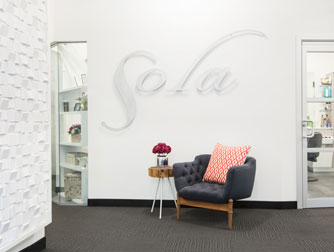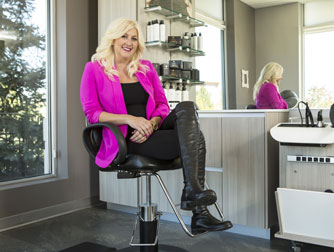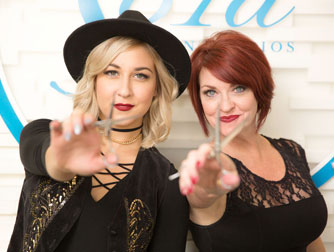Our Blog
Hair
Hair Products: Professional vs. Store Brand
Posted on June 25, 2014
Barb Quinn
As a professional hair stylist, you’ve undoubtedly had clients who questioned the differences between the higher priced salon brands and the much more affordable hair products available at big box retailers. Between the extensive training we went through and our hands-on, day-to-day experiences, we understand that there’s a substantial difference between hair products. However, a few minutes of side-to-side comparisons can often clear up any uncertainties clients may have. Here are some of the main differences, as well as client benefits, associated with salon brands versus store brands.
Better Ingredients, Better Products
Before you begin, understand that clients are often inundated with glossy photos of perfectly-coiffed mass market brand ambassadors along with well-crafted advertising campaigns claiming the lower-priced alternative is equal to salon brands in every way except cost. Bearing that in mind, you--as the professional--can highlight common differences.
First is concentration. Store brands often list many of the same ingredients contained in salon products, but they are far less concentrated. The ingredient list on the back of the store brands will often include the most desirable ingredients toward the end of the list. Simply put -- it’s in there, but not much of it. The other glaring difference often seen in store brands is the first ingredient which, in many cases, is water. By contrast, those highly concentrated salon formulas last far longer, which means the cost differential isn’t nearly as wide as they may have initially believed.
Next are the surfactants. Those detergents which generate lather are listed using names that can sound similar yet operate very differently on the hair. For example, salon brands often contain sodium laureth sulfate which is much gentler on the hair but produces less lather. The less expensive store brands, however, often contain sodium laurel sulfate (or ammonium laurel sulfate), a far more abrasive option that can rob the hair of moisture and essential nutrients and can strip the hair of color applications. The latter options do, however, generate more lather which leads many clients to think the product is doing a superior job of cleansing the hair.
Finally, the other “stuff.” A quick review of the ingredients in many popular store brands will quickly reveal the widespread use of harmful agents such as alcohol and ammonia. Some of these store brands have also begun using inferior grade waxing agents which tend to build up over time, thereby reducing the effectiveness of color treatments. What often happens, after extended use, is clients begin to notice their hair becoming dry and lackluster, causing them to return to the store to find “hydrating” products to counteract the damage. By contrast, the salon products we use each day often include hair and scalp nourishing vitamins, minerals and healthy oils -- all designed to keep the hair in optimal condition.
Maintaining Color Treated Hair
For your clients with color treated hair, the difference in the store and salon brands may be even more pronounced. Of course, color treatments look best on hair that is healthy, shiny and well-hydrated--all of which are promoted by the ingredients found in salon products. But you may also want to remind clients that those inferior products can (and often do) create buildup that prevents the color from penetrating the hair properly. Without that, the color simply does not last as long, forcing them to schedule color treatments more frequently.
Investment
The age-old adage, ‘you get what you pay for’ is definitely accurate where hair care products are concerned. Professional products are created with ingredients that are more potent, more powerful and more effective. It stands to reason that they would, in turn, cost their manufacturers more to produce. For many clients, the shift in perspective may come down to thinking of the salon products as an investment in themselves. Sure, the initial outlay may be greater, but so too, is the payoff--both in the condition and feel of their hair and in how the client feels while presenting their best selves to the world. To borrow from another phrase we all know well: ‘When you look good, you feel good.’ To conclude, a little client education can go a long way in dispelling those marketing myths mass market manufacturers want consumers to believe. As a professional stylist, there simply is no one better positioned to help clients understand that all hair products are definitely not created equal.
 Guest author Barb Quinn has been a professional hairstylist for over 30 years and has established herself as a nationally recognized hair designer, educator, and freelance writer. Barb has been chosen by her peers to serve on the advisory panel of Cosmos C International the global hairstylist network and is the Men's Hair Category Expert for Answers.com. Thousands of women each day follow Barb's hairstyling wit and wisdom on her highly successful blogs Hairstyle-Blog.com and Visual-Makeover.com.
Guest author Barb Quinn has been a professional hairstylist for over 30 years and has established herself as a nationally recognized hair designer, educator, and freelance writer. Barb has been chosen by her peers to serve on the advisory panel of Cosmos C International the global hairstylist network and is the Men's Hair Category Expert for Answers.com. Thousands of women each day follow Barb's hairstyling wit and wisdom on her highly successful blogs Hairstyle-Blog.com and Visual-Makeover.com.








